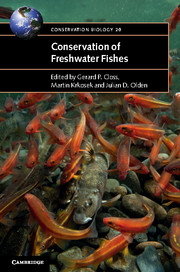Book contents
- Frontmatter
- Contents
- List of contributors
- Preface
- 1 Lost fishes, who is counting? The extent of the threat to freshwater fish biodiversity
- 2 Why are freshwater fish so threatened?
- 3 Climate change effects on freshwater fishes, conservation and management
- 4 Challenges and opportunities for fish conservation in dam-impacted waters
- 5 Chemical pollution
- 6 Multiple stressor effects on freshwater fish: a review and meta-analysis
- 7 Infectious disease and the conservation of freshwater fish
- 8 Non-indigenous fishes and their role in freshwater fish imperilment
- 9 Riparian management and the conservation of stream ecosystems and fishes
- 10 Fragmentation, connectivity and fish species persistence in freshwater ecosystems
- 11 Conservation of migratory fishes in freshwater ecosystems
- 12 Protecting apex predators
- 13 Artificial propagation of freshwater fishes: benefits and risks to recipient ecosystems from stocking, translocation and re-introduction
- 14 Freshwater conservation planning
- 15 Sustainable inland fisheries – perspectives from the recreational, commercial and subsistence sectors from around the globe
- 16 Understanding and conserving genetic diversity in a world dominated by alien introductions and native transfers: the case study of primary and peripheral freshwater fishes in southern Europe
- 17 Maintaining taxonomic skills; the decline of taxonomy – a threat to fish conservation
- 18 Synthesis – what is the future of freshwater fishes?
- Index
- References
13 - Artificial propagation of freshwater fishes: benefits and risks to recipient ecosystems from stocking, translocation and re-introduction
Published online by Cambridge University Press: 05 December 2015
- Frontmatter
- Contents
- List of contributors
- Preface
- 1 Lost fishes, who is counting? The extent of the threat to freshwater fish biodiversity
- 2 Why are freshwater fish so threatened?
- 3 Climate change effects on freshwater fishes, conservation and management
- 4 Challenges and opportunities for fish conservation in dam-impacted waters
- 5 Chemical pollution
- 6 Multiple stressor effects on freshwater fish: a review and meta-analysis
- 7 Infectious disease and the conservation of freshwater fish
- 8 Non-indigenous fishes and their role in freshwater fish imperilment
- 9 Riparian management and the conservation of stream ecosystems and fishes
- 10 Fragmentation, connectivity and fish species persistence in freshwater ecosystems
- 11 Conservation of migratory fishes in freshwater ecosystems
- 12 Protecting apex predators
- 13 Artificial propagation of freshwater fishes: benefits and risks to recipient ecosystems from stocking, translocation and re-introduction
- 14 Freshwater conservation planning
- 15 Sustainable inland fisheries – perspectives from the recreational, commercial and subsistence sectors from around the globe
- 16 Understanding and conserving genetic diversity in a world dominated by alien introductions and native transfers: the case study of primary and peripheral freshwater fishes in southern Europe
- 17 Maintaining taxonomic skills; the decline of taxonomy – a threat to fish conservation
- 18 Synthesis – what is the future of freshwater fishes?
- Index
- References
Summary
We must not think that the highly laudable but expensive art and science of restoration ecology is going to put back ecosystem integrity, even though it ‘regreens’ with a highly convincing look-alike. –
M. J. Samways (1996)INTRODUCTION
This book examines emerging and historical perspectives and approaches to the conservation of inland fish biodiversity and the freshwater ecosystems upon which this diversity relies. Together, these approaches present enormous opportunities, yet daunting challenges, in efforts to sustain viably functioning freshwater ecosystems with the full complement of ecosystem services and societal values they provide. In this chapter, we focus the reader's attention to a set of interrelated practices aimed at augmenting the production of new recruits to a targeted population and ecosystem often as means to restore or conserve fish populations. These practices include artificial propagation and stocking, direct translocation and re-introduction (NB: key terms used herein are italicised on first use and defined in Box 13.1. Many of these terms have no widely accepted definitions in practice. Therefore, we provide these as they relate to our usage). Widely used in fisheries management, aquatic conservation and restoration, these activities are the subject of considerable scrutiny and lingering debate as to whether they truly provide a demonstrable ecological benefit as opposed to a suite of more societal benefits (economic, cultural, political, and so on). Moreover, critical examination of whether such benefits justify or balance the attendant risks to recipient biodiversity and ecosystems are generally lacking. We address both sides of the debate by presenting a general discussion of the kinds, range and magnitude of benefits and risks associated with artificial enhancement practices including those used under the banner of ‘conservation’, but also more generally. Where space and information permit, we also provide evidence gleaned from specific cases documented from the literature or the authors’ experiences. We acknowledge a bias toward examples gleaned from our North American experiences with inland and anadromous species, but suggest that underlying concepts are common and broadly relevant to any fauna regardless of geographical location.
- Type
- Chapter
- Information
- Conservation of Freshwater Fishes , pp. 399 - 436Publisher: Cambridge University PressPrint publication year: 2015
References
- 4
- Cited by



